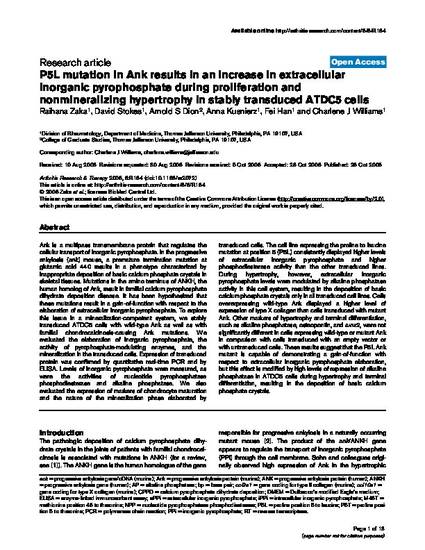
Ank is a multipass transmembrane protein that regulates the cellular transport of inorganic pyrophosphate. In the progressive ankylosis (ank) mouse, a premature termination mutation at glutamic acid 440 results in a phenotype characterized by inappropriate deposition of basic calcium phosphate crystals in skeletal tissues. Mutations in the amino terminus of ANKH, the human homolog of Ank, result in familial calcium pyrophosphate dihydrate deposition disease. It has been hypothesized that these mutations result in a gain-of-function with respect to the elaboration of extracellular inorganic pyrophosphate. To explore this issue in a mineralization-competent system, we stably transduced ATDC5 cells with wild-type Ank as well as with familial chondrocalcinosis-causing Ank mutations. We evaluated the elaboration of inorganic pyrophosphate, the activity of pyrophosphate-modulating enzymes, and the mineralization in the transduced cells. Expression of transduced protein was confirmed by quantitative real-time PCR and by ELISA. Levels of inorganic pyrophosphate were measured, as were the activities of nucleotide pyrophosphatase phosphodiesterase and alkaline phosphatase. We also evaluated the expression of markers of chondrocyte maturation and the nature of the mineralization phase elaborated by transduced cells. The cell line expressing the proline to leucine mutation at position 5 (P5L) consistently displayed higher levels of extracellular inorganic pyrophosphate and higher phosphodiesterase activity than the other transduced lines. During hypertrophy, however, extracellular inorganic pyrophosphate levels were modulated by alkaline phosphatase activity in this cell system, resulting in the deposition of basic calcium phosphate crystals only in all transduced cell lines. Cells overexpressing wild-type Ank displayed a higher level of expression of type X collagen than cells transduced with mutant Ank. Other markers of hypertrophy and terminal differentiation, such as alkaline phosphatase, osteopontin, and runx2, were not significantly different in cells expressing wild-type or mutant Ank in comparison with cells transduced with an empty vector or with untransduced cells. These results suggest that the P5L Ank mutant is capable of demonstrating a gain-of-function with respect to extracellular inorganic pyrophosphate elaboration, but this effect is modified by high levels of expression of alkaline phosphatase in ATDC5 cells during hypertrophy and terminal differentiation, resulting in the deposition of basic calcium phosphate crystals.
Available at: http://works.bepress.com/charlene-williams/61/
